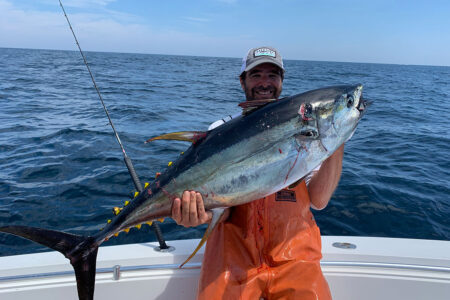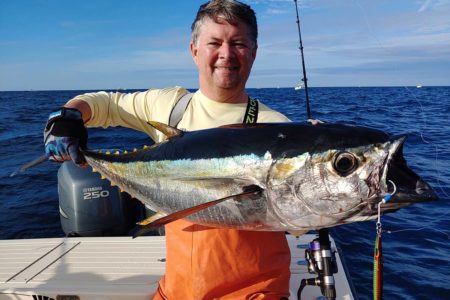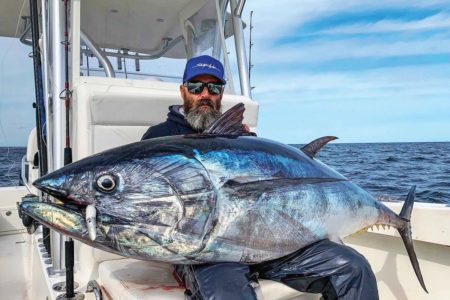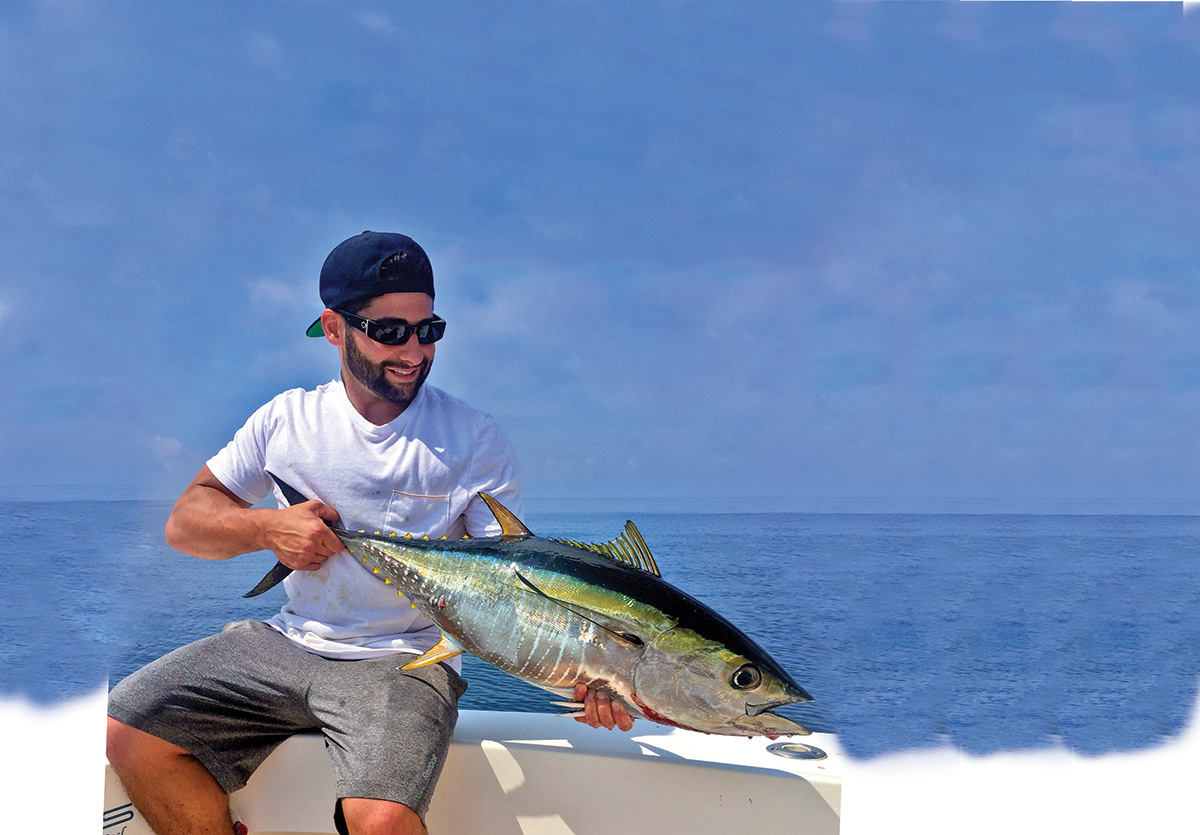
A few tips to help increase your daily take at the edge!
Yellowfin are the bread and butter of the charter fleet. Sure marlin, bluefin, mahi and a host of other deep water finned friends are appreciated when they bend a rod. But for charter clients or anglers fishing in the cockpits of the private fleet, yellowfin are first and foremost on most minds when dock lines are cast off.
With a generous three fish allotment per angler, it is not uncommon to see 18 yellowfin thrown up on the dock at day’s end to be weighed, cleaned and cut into many tasty meals. The question many anglers have when observing these types of catches is, how did they catch them?
Expand Your Network
Being a client on a charter boat, watching what is attached to the end of the lines and ultimately how the spread is set is only a part in catching yellowfin. Water temperature, clarity and food source are all key factors to any productive offshore day of fishing. And rods are not going to bend over if bait is not in the vicinity of fish!
For many weekend anglers, there is no better way to find out where the recent bite has been than by making friends with a captain or mate of a charter boat who fishes every day and follows the fish. Walking the docks, smiling and asking questions can be rewarding. The charter fleet in almost every marina along the coast is the same; everyone gets along for the most part; but there are cliques, and each clique shares information within a sometimes tight circle. Secret radio channels are quickly falling by the wayside as captains reach for the SAT phone to relay a bite to buddies. This leaves many anglers with puzzle pieces that need to be assembled for success.
Sea Surface Temperature (SST) readouts give indication as to where temperature breaks can be found, which will hold the necessary ingredients to produce results. Typically, this is where you find a large number of the charter fleet boats; although finding the charter fleet and catching the number of tuna they do are two separate issues.
The Gulf Stream moves from south to north, however when an eddy spins off, the water spins/moves independently. Meaning, in our Northeast Canyons, the west side of the eddy (closest to shore) often moves water current in a direction of north to south. Why is this important? Typically fish move with the current. While looking for a school of yellowfin (or any species for that matter) anglers should be trolling with the current. As such, studying a satellite image to find out which direction current is moving is for general purposes only; nothing beats determining this on site.
Determining Trolling Direction
By trolling a couple different directions, action of the bait and boat speed over bottom tells exactly the direction of current. Spend enough time on the water and the eyes learn to determine direction. When fishing an eddy or finger of water (Gulf Stream water that has not yet separated from main body) anglers are looking for the temperature break. Breaks have cold and warm sides. A break may only be 1 degree or could be a 3- to 4-degree change.
Yellowfin normally swim perpendicular with the temperature break while searching for meals; this means crisscrossing the temperature break while trolling is not optimal for finding yellowfin. They typically are found on the “warm” side of the break, especially when the temperature falls within their preferred range in the low 70s. So, concentrating the trolling pattern in the direction of the current on the warm side increases your chances of finding fish.
On the other hand, do not discount the cold side when fish cannot be located. There are always exceptions to the rule, and more than once the bite has been found trolling against current on the cold side. But since baitfish swim with the current, and predators follow the meals, trolling with current on the warm side is a best bet. Typically a weed line or debris can be found accumulating somewhere along the break in the calm sections of water. But if not, do not discount working just the temperature break, which has plankton clouding up the water beginning the food chain.
Watch your sonar for fish holding deep and keep an eye out for our feathered friends sitting on the water or gliding about in search of their next meal. This pretty much says the boat is trolling in the correct area; keep in mind fish do not feed 24/7. When fish won’t rise in the water column the use of a Z-Wing or planer often puts a fish or two in the box. While trolling deep is not normally part of a yellowfin trolling spread, if bait and fish are holding deep, it can be worth the effort to pull in a flat line and deploy a deep bait like a dark colored skirted ballyhoo.

Don’t Overthink It
When yellowfin rise to feed, just about everything in the spread is up for grabs. When bites are far and few between, anglers often change offerings hoping to entice a tuna into bending a rod. The color of skirts, size of bait, types of bait may all get changed, or a dust covered artificial lure that hasn’t been wet in years might get dug out of the box. After a bad day of trolling, often a trip to the tackle shop is in order to buy that new sparkling hot lure hanging under shimmering lights. Every angler looks to improve their chances of attracting yellowfin into the spread; just remember though that there is no magical lure/bait. When a school rises to feed, everything can be a meal. Tuna are partial to whatever they are feeding on, and checking the stomach contents of the first yellowfin caught gives an indication of the size of bait to offer.
When fish are not feeding, there is no reason to throw the baby out with the bathwater; drag what normally works! The Boss Hogg out of Ocean City, MD is one of the top tuna boats along the East Coast, consistently throwing large stringer catches on the dock day after day when others struggled to put three or four yellowfin in the kill box; this is not a matter of luck. Boss Hogg’s Capt. Josh Ruskey says the key is to keep it simple.
“Don’t overthink this,” Ruskey told me this spring, detailing his use of a 10-rod spread, consisting of eight skirted ballyhoo and two spreader bars pulled off the short riggers. Also two squid daisy chains are used as teasers, which will also raise marlin. As for ballyhoo skirt colors, he is partial to blue/white and black/blue, but repeated, “Don’t overthink this.” It was May 12 when we spoke; the day before, Capt. Ruskey was teamed up with Capt. Chris Gornell on the Fin Planner out of Oregon Inlet Fishing Center on the Outer Banks where they threw 16 yellowfin on the dock along with a handful of mahi; day before that, same results, and using the very same spread.
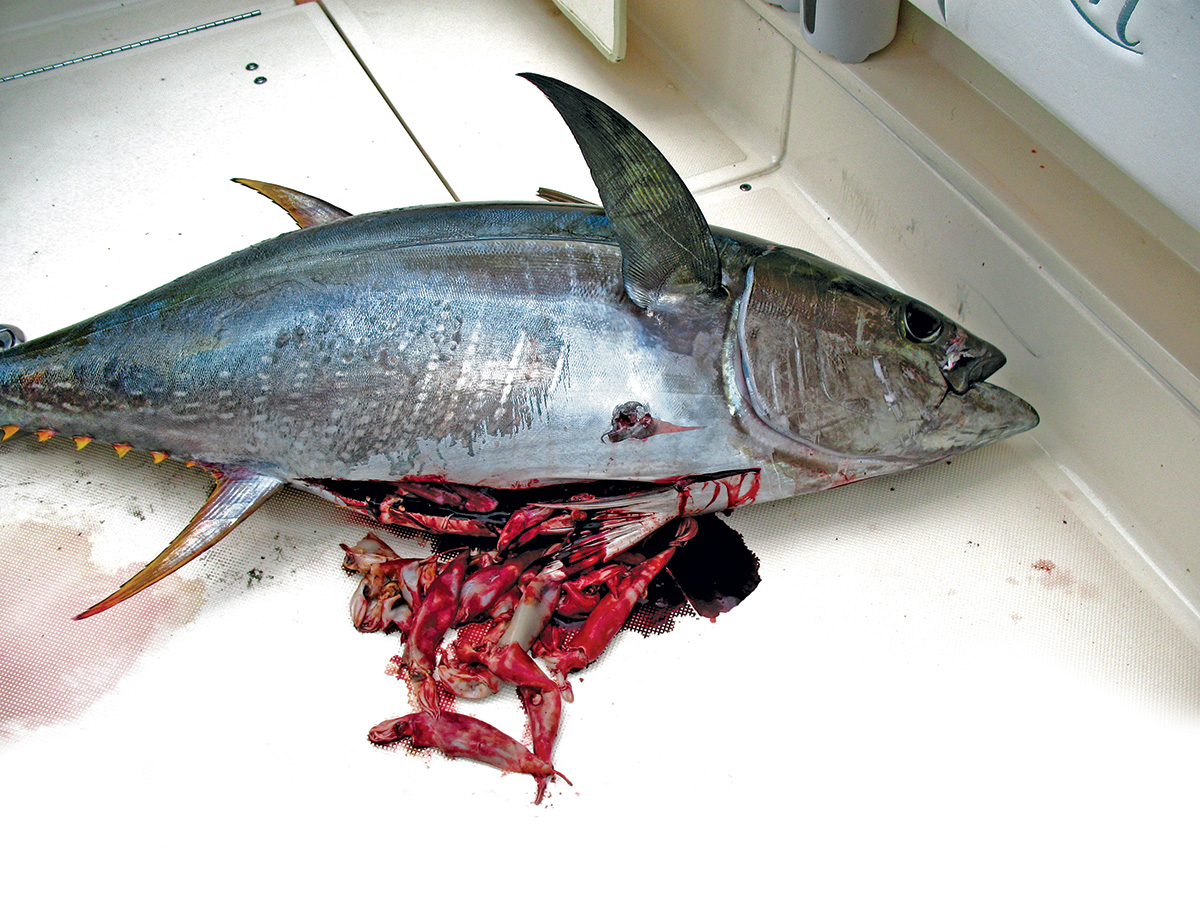
Green Stickin’ Yellows
There is a tactic that has become popular the last couple years, although it has been around for decades. Many anglers became aware of green sticking for bluefin from watching the TV series Wicked Tuna. And today, many boats in the charter fleet occasionally deploy some type of similar setup for yellowfin.
Unlike the commercial version or setup many of the battle wagons in charter fleets use, my rig can be pulled off any boat with a decent set of outriggers. As you’ll see in the illustration, you have 40 feet of leader with a three-way swivel for attaching the dangling squid rigged with a double hook (An additional three-way swivel can be inserted in the leader for two dangling squid.). The flat head teaser on 5 feet of leader is also rigged with a hook. Each rig needs to be tailored to the boat, depending on rigger height; this means changing the length of line for the dangling squid.
Position it around the second to third wave, and strive to have the squid in the water no more than 50 percent of the time. Many bites come as the squid leaves the water to fly in the air. Watching yellowfin go airborne and grabbing the squid in mid-air is a sight not soon forgotten!
Finally, make the most of a bite. I can recall that first yellowfin many years ago. A line went off and everyone went into action. One buddy grabbed the rod with the drag screaming, and everyone else began winding in the remaining lines as fast as possible. This type of procedure means only one fish will be caught. A bite may last for an hour, and lucky anglers might put two or three yellowfin in the box catching one at a time. Charters working the very same bite may end up with eight or more yellowfin; those boats are burning a hole in the ocean.
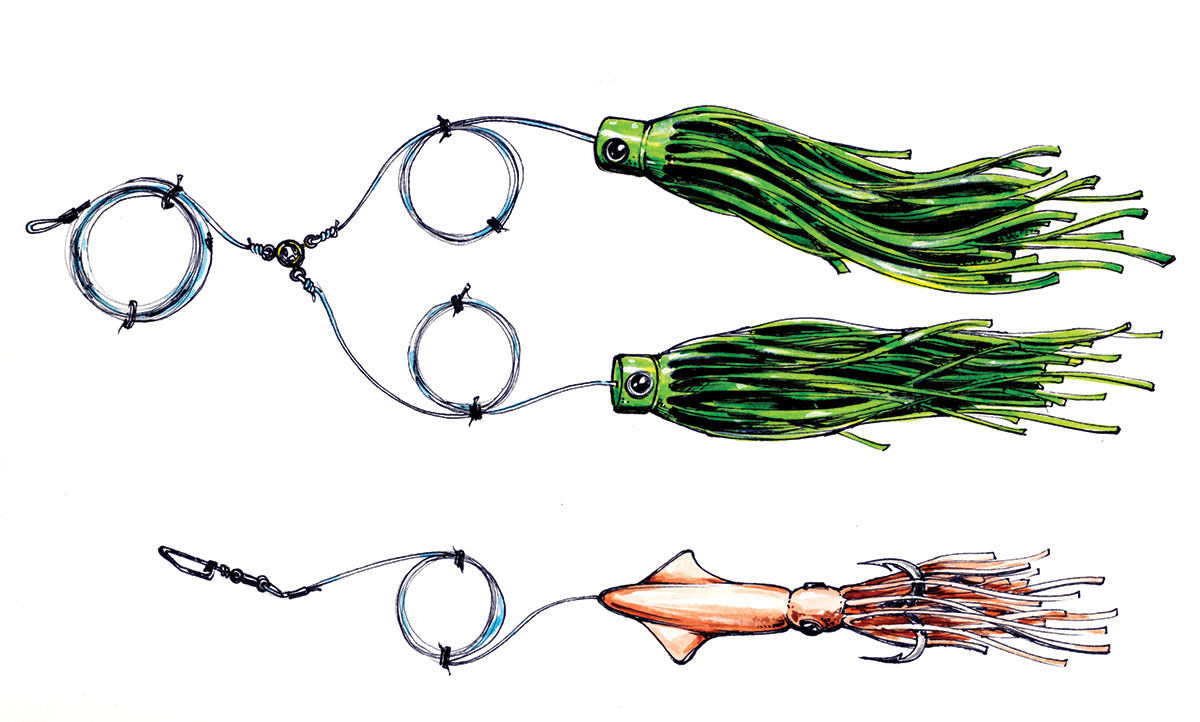
Illustration by Pete Kosciukiewicz
When that first rod goes down the boat begins to make a gentle turn in the direction the first tuna is running. The crew then has an extremely important task – everyone grabs a line and begins to jerk, putting additional action into the baits. Yellowfin are a school fish, and the extra action initiates additional bites. This technique is the ticket to multiple hookups and the addictive excitement of offshore fishing.
There is a lot involved in trolling for yellowfin, and nothing is more important as teaching a crew to grab lines upon a bite. Burning a hole is one factor why charter boats often come to the scale with those limits of yellowfin tuna.
For additional yellowfin tips and techniques, check out John Unkart’s books Offshore Pursuit and Saltwater Tales.

